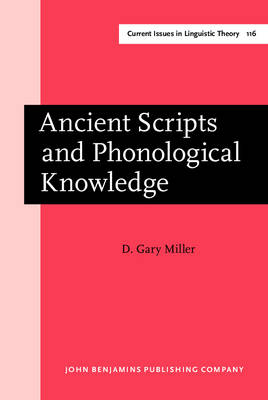
Ancient Scripts and Phonological Knowledge
Seiten
1994
John Benjamins Publishing Co (Verlag)
978-90-272-3619-7 (ISBN)
John Benjamins Publishing Co (Verlag)
978-90-272-3619-7 (ISBN)
Topics covered in this volume include: the linear B syllabary; the Cyprian syllabary; the Greek alphabet; the Runic alphabet; and literacy and linguistic knowledge. The book concludes by examining the possibilities for devising an efficient syllabary.
This study investigates the properties of several ancient syllabic and linear segmental scripts to make explicit the aspects of linguistic knowledge they attempt to represent. Some recent experimental work suggests that nonliterate speakers do not have segmental knowledge and that only syllabic knowledge is 'real' or accessible, whence the ubiquity of syllabaries. Miller disputes this by showing that such tests do not distinguish relevant types of knowledge, and that linguistic analysis of the ordering and writing conventions of early Western scripts corroborates the evidence from language acquisition, use, and change for segment awareness. By coding segments, the ancient syllabaries represented more phonological knowledge than the alphabet, which was a poor compromise between the vowelless West Semitic scripts and the vowel-redundant syllabic scripts.
A wide range of information about early scripts and their development is combined with a new theory of the syllable as 'Sonority Phrase'. The book's value is further enhanced by thorough discussion of the issues from a broad range of theoretical and applied viewpoints, including language play and change, cognition, literacy, and cultural history.
This study investigates the properties of several ancient syllabic and linear segmental scripts to make explicit the aspects of linguistic knowledge they attempt to represent. Some recent experimental work suggests that nonliterate speakers do not have segmental knowledge and that only syllabic knowledge is 'real' or accessible, whence the ubiquity of syllabaries. Miller disputes this by showing that such tests do not distinguish relevant types of knowledge, and that linguistic analysis of the ordering and writing conventions of early Western scripts corroborates the evidence from language acquisition, use, and change for segment awareness. By coding segments, the ancient syllabaries represented more phonological knowledge than the alphabet, which was a poor compromise between the vowelless West Semitic scripts and the vowel-redundant syllabic scripts.
A wide range of information about early scripts and their development is combined with a new theory of the syllable as 'Sonority Phrase'. The book's value is further enhanced by thorough discussion of the issues from a broad range of theoretical and applied viewpoints, including language play and change, cognition, literacy, and cultural history.
1. Acknowledgements; 2. Abbreviations; 3. 0. Preface; 4. 1. Theoretical Prerequisites; 5. 2. The Linear B Syllabary; 6. 3. The Cyprian Syllabary; 7. 4. The Greek Alphabet; 8. 5. The Runic Alphabet; 9. 6. Literacy and Linguistic Knowledge; 10. 7. Implications: An Ideal Script?; 11. Appendices; 12. References; 13. General Index
| Erscheint lt. Verlag | 6.9.1994 |
|---|---|
| Reihe/Serie | Current Issues in Linguistic Theory ; 116 |
| Verlagsort | Amsterdam |
| Sprache | englisch |
| Maße | 164 x 245 mm |
| Gewicht | 340 g |
| Themenwelt | Geschichte ► Hilfswissenschaften ► Paläografie |
| Geisteswissenschaften ► Sprach- / Literaturwissenschaft ► Sprachwissenschaft | |
| ISBN-10 | 90-272-3619-4 / 9027236194 |
| ISBN-13 | 978-90-272-3619-7 / 9789027236197 |
| Zustand | Neuware |
| Haben Sie eine Frage zum Produkt? |
Mehr entdecken
aus dem Bereich
aus dem Bereich
Schnelle Hilfe bei häufigen Fehlern
Buch | Softcover (2021)
UTB (Verlag)
CHF 25,20
Eine Geschichte der Welt in neun geheimnisvollen Schriften
Buch | Hardcover (2021)
C.H.Beck (Verlag)
CHF 34,95


